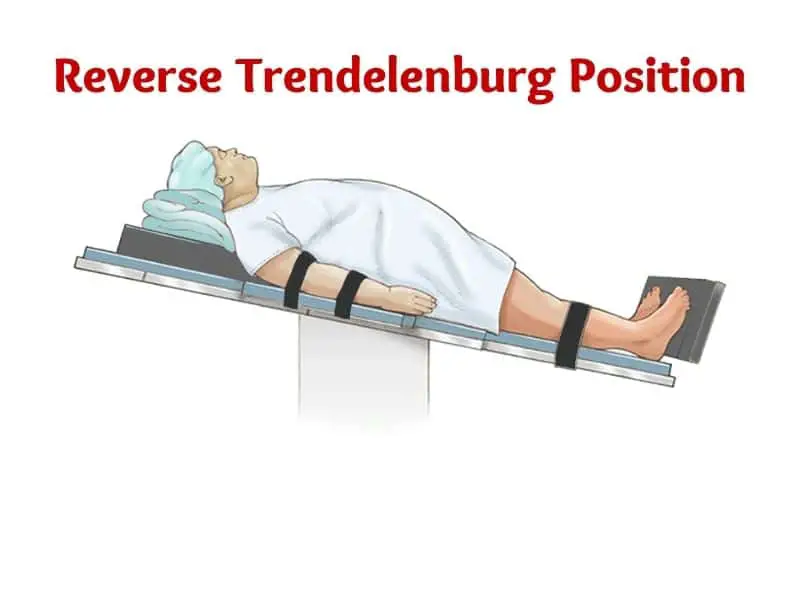Reverse Trendelenburg Position
The reverse Trendelenburg position is the opposite of the Trendelenburg position. Which are variations of dorsal or supine positions.
Reverse Trendelenburg position can be described as foot-down and head-up supine position. In which the patient’s hip is higher than the leg and head is higher than the pelvis.
Reverse Trendelenburg position is commonly used in OR for the head, neck, and upper abdominal surgeries. But rarely used in day-to-day inpatient care.
The nurse sometimes uses reverse Trendelenburg position during nasogastric (NG) tube insertion and feeding, if the patient must remain in the supine position.
Definition
Reverse Trendelenburg position can be defined as a “position in which the lower extremities are low and the body and head are elevated on an inclined plane” (Perry, Potter, and Ostendorf, 2014, p1165).

Reverse Trendelenburg position indication
- For nasogastric (NG) tube insertion, if patient cannot be propped up.
- For NG and enteral tube feeding, if patient must remain in supine position.
Anesthetic and surgical indications of reverse Trendelenburg position include:
- Shoulder, neck, and head surgeries
- Laparoscopic and robotic surgeries of the upper abdomen
- To improve surgical exposure of the prostate
- Minimally invasive glaucoma surgery
- Intubation and extubation of obese patient
Benefits of Reverse Trendelenburg position
The benefits of the reverse Trendelenburg’s position are as follows.
- Helps to reduce central venous pressure (CVP) without significantly reducing the systolic blood pressure (SBP).
- Safe position to perform hepatectomy without clamping inferior vena cava (1).
- Effective position for laparotomy in obese patient, because reverse Trendelenburg helps to maintain adequate blood oxygen levels with minimal arterial pressure changes (2).
- Increases residual functional capacity of the lungs and increases lung compliance
- Helps gastric emptying
- Prevents GERD (gastroesophageal reflux)
- Can be used to improve respiratory functions of patients with lung diseases, obesity, and pregnant patients undergoing general anesthesia.
- Helps to shift abdominal organs away from the surgical site to improve visualization
How to position patient in reverse Trendelenburg position?
The steps for positioning the patient to reverse Trendelenburg are as follows.
- Straighten the bed and position patient in supine position
- Ensure proper alignment of the patient’ body and extremities
- Secure patient properly to prevent slipping
- Tilt the whole bed frame head-end upwards and foot-end downwards
- If the patient is to be positioned in steep reverse Trendelenburg, use padded support to the ankle and feet
- Keep both arms at the side
Contraindications of Reverse Trendelenburg position
Contraindications of reverse Trendelenburg are:
- Hypovolemia
- Advanced age
- Pre-existing cardiovascular diseases
Complications of Reverse Trendelenburg Position
Complications and risks of reverse Trendelenburg position are as follows.
- Decrease venous returns
- Decrease cardiac output
- Hypotension
- Venous pooling in the lower extremities
- Deep vein thrombosis (DVT)
- Can increase peripheral resistance due to CO2 insufflation
Conclusion
In conclusion, the reverse Trendelenburg position is a commonly used position for surgeries of the upper body but rarely used in inpatient care.
For example, reverse Trendelenburg is used for head and neck procedures. It also allows greater visualization in laparoscopic procedures of the upper abdomen.
Reverse Trendelenburg position’s definition, indication, benefits, contraindication, and complications are discussed above in detail.
Patient Positioning for Nurses
Lithotomy Position |Indication |Variations |Nerve injuries
Reference
Alexander, E., McEwen, D., & Rothrock, J. (2019). Alexander’s Care of the Patient in Surgery (16th ed.). Elsevier.
Kneedler, J., & Dodge, G. (1994). Perioperative Patient Care: The Nursing Perspective. Jones and Bartlett.
Macksey, L., Sowka, W., Kaufman, P., & Kallaway, F. (2012). Surgical Procedures and Anesthetic Implications: A Handbook for Nurse Anesthesia Practice. Jones & Bartlett Learning, LLC.
Perry, A., Potter, P., & Ostendorf, W. (2014). Clinical Nursing Skills & Techniques (8th ed.). Mosby/Elsevier.
Servant, C., Purkiss, S., & Hughes, J. (2009). Positioning Patients for Surgery. Cambridge University Press.




